Why the shift from ‘job replacement’ to ‘task automation’ is a much healthier way to think about the future of work with AI.
Have you noticed the change in tone lately? For years, the conversation around artificial intelligence has been dominated by a single, scary thought: “AI is going to take our jobs.” It was a sci-fi doomsday scenario playing out in our professional lives. But recently, the dialog has shifted to something quieter, more nuanced, and frankly, a lot more interesting. We’ve started talking less about AI replacing jobs and more about AI replacing tasks. And I think that’s a much healthier—and more accurate—way to look at the future.
This isn’t just semantics. It’s a fundamental change in perspective. A “job” is a complex collection of responsibilities, skills, and human interactions. A “task” is a single, definable action within that job. Thinking in these terms helps us see that AI isn’t an all-or-nothing threat, but a tool that can be surgically applied to specific parts of our workflow.
Why ‘AI Replacing Tasks’ is a Smarter Conversation
Let’s be honest, every job has parts that are, well, a slog. Think about the tedious, repetitive, and time-consuming things you do every week.
- Manually entering data into a spreadsheet.
- Sorting through hundreds of emails to find key information.
- Summarizing long meeting transcripts.
- Formatting reports and presentations.
These tasks are necessary, but they rarely require our uniquely human skills like creativity, empathy, or strategic thinking. They’re the perfect candidates for automation. A recent report from McKinsey & Company highlights how automation can handle these routine activities, freeing up humans to focus on higher-value work.
When we talk about AI replacing tasks, we’re not talking about making the human obsolete. We’re talking about giving the human an upgrade. It’s about clearing the administrative clutter from our desks so we have more time and mental energy for the work that truly matters—the work we actually enjoy.
Your New Role: The Human in the Loop
This shift puts us in a new and powerful position: the “human in the loop.” Instead of being a cog in the machine, we become the pilot. We are the strategists who decide which tasks to delegate to our AI assistants. We provide the context, set the goals, and make the final judgment call on the output.
Think of it like this: a film director doesn’t operate the camera, manage the lighting, and edit every scene themselves. They have a team and a suite of tools to execute their vision. The director’s job is to orchestrate these elements to tell a compelling story.
In the near future, many of us will work in a similar way. We will orchestrate a suite of AI tools to perform specific functions, stringing their outputs together to complete a complex project. Our value won’t come from our ability to manually process information, but from our ability to ask the right questions, guide the technology, and apply a layer of critical thought that AI can’t replicate. As an article from Harvard Business Review points out, the most effective results come from a partnership between human creativity and AI’s capabilities.
What the Focus on AI Replacing Tasks Means for You
So, what should you do right now? Instead of worrying about your job title becoming obsolete, take a practical look at your daily to-do list.
- Identify the Tedium: What are the top 3-5 most repetitive tasks you do every week? Could they be automated? Start exploring simple AI tools that exist today for things like email summaries, content brainstorming, or data analysis.
- Double Down on Human Skills: Where do you add the most value? It’s probably in areas like building client relationships, mentoring junior colleagues, negotiating complex deals, or creative problem-solving. This is your safe zone. Spend more time honing these irreplaceable skills.
- Get Curious, Not Scared: The best way to understand this shift is to engage with it. Play around with some of the AI tools available. See what they’re good at and, more importantly, where they fall short. This firsthand knowledge will make you more valuable, not less.
The narrative is finally catching up to reality. AI isn’t a tidal wave coming to wash our careers away. It’s a powerful current we can learn to navigate. By focusing on AI replacing tasks, not jobs, we can move from a place of fear to a place of opportunity, where technology helps us become better, faster, and more creative versions of our professional selves. And that’s a future I can get behind.
